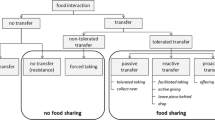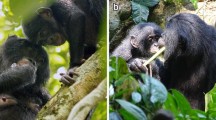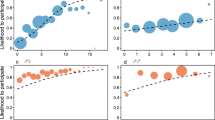Abstract
Why do animals help other individuals and provide benefits to the recipient, sometimes at personal cost? In this study, we aim to determine if some of the helpful behaviors observed in a group of wild chimpanzees (Taï chimpanzee group, Côte d'Ivoire, West Africa) are exchanged among individuals resulting in a net benefit for both participants. We adopted an inclusive view of exchanges by considering that all commodities (i.e., social behaviors as grooming, sex, support, as well as resources, such as meat) can be exchanged. This would result in “market” type social interactions in which debts of one commodity can be met by giving the same or other commodities. We investigated whether both in-kind exchanges and trades of commodities occurred. The Taï chimpanzees reciprocated the amount of grooming they received and were more likely to give support in agonistic conflicts to those who also supported them. In addition, they traded support for meat and meat for sex. Both male and female chimpanzees exchanged many different commodities, which seemed to result in long-term balanced relationships. Our results suggest that wild chimpanzees rely on other group members to obtain many of the important commodities they need.


Similar content being viewed by others
Notes
As each predictor variable included in a model affect the remaining predictor variables and the response variable in a different way, it is important to test each variable both as a predictor and as a response variable.
Note that the results of this analysis differ slightly from the ones presented in Gomes et al. (2009). As the goal of each paper was different, so were the analyses. In this analysis, we incorporated all of the dyads, including those in which only one individual in the pair groomed its partner, whereas in Gomes et al. (2009) we did not.
Note that the results of this analysis differ slightly from the ones presented in (Gomes and Boesch 2009). The response variable in this analysis is copulation rate whereas in the previous paper it was total copulation counts.
Many studies have used matrix correlations which allow investigating the relationship between two variables while controlling for a third confounding factor. Although this was the appropriate analysis, and best one available at the time these studies were done, it does not allow investigating the relationships of more than three variables simultaneously. In light of the statistics available now, it would be interesting to reanalyze these data to determine whether there are any differences in the relationships found.
References
Altmann J (1974) Observational study of behavior: sampling methods. Behaviour 49:227–265
Arnold K, Whiten A (2003) Grooming interactions among the chimpanzees of the Budongo Forest, Uganda: tests of five explanatory models. Behaviour 140:519–552
Aureli F, Schino G (2004) The role of emotions in relationships. In: Thierry B, Singh M, Kaumanns W (eds) Macaque societies: a model for the study of social organization. Cambridge University Press, Cambridge, pp 38–60
Aureli F, Preston SD, de Waal FBM (1999) Heart rate responses to social interactions in free-moving rhesus macaques (Macaca mulatta): a pilot study. J Comp Psychol 113:59–65
Baayen RH (2008) Analyzing linguistic data. A practical introduction to statistics. Cambridge University Press, Cambridge
Barrett L, Henzi SP, Weingrill T, Lycett JE, Hill RA (1999) Market forces predict grooming reciprocity in female baboons. Proc R Soc B 266:665–670
Bates D, Maechler M, Bolker B (2011) Package lme4. R: online http://cran.r-project.org/web/packages/lme4/lme4.pdf
Blurton-Jones NG (1984) A selfish origin of human food sharing-tolerated theft. Ethol Sociobiol 5:1–3
Boesch C (1994) Cooperative hunting in wild chimpanzees. Anim Behav 48:653–667
Boesch C (2002) Variation in chimpanzee–red colobus interactions. In: Boesch C, Hohmann G, Marchant LA (eds) Behavioural diversity in chimpanzees and bonobos. Cambridge University Press, Cambridge, pp 221–230
Boesch C (2009) The real chimpanzee: sex strategies in the forest. Cambridge University Press, Cambridge
Boesch C, Boesch H (1989) Hunting behavior of wild chimpanzees in the Taï National Park. Amer J Phys Anthrop 78:547–573
Boesch C, Boesch-Acherman H (2000) The chimpanzees of the Taï Forest. Oxford University Press, Oxford
Boesch C, Hohmann G, Marchant LA (2002) Behavioural diversity in chimpanzees and bonobos. Cambridge University Press, Cambridge
Boesch C, Boesch H, Vigilant L (2006) Cooperative hunting in chimpanzees: kinship or mutualism? In: Kappeler PM, van Schaik CP (eds) Cooperation in primates and humans: mechanisms and evolution. Springer, Berlin, pp 139–150
Bolker B (2007) Ecological models and data in R. Princeton University Press, Princeton
Brosnan SF, de Waal FBM (2005) Responses to a simple barter task in chimpanzees, Pan troglodytes. Primates 46:173–182
Brosnan SF, Silk JB, Henrich J, Mareno MC, Lambeth SP (2009) Chimpanzees (Pan troglodytes) do not develop contingent reciprocity in an experimental task. Anim Cogn 12:587–597
Chancellor RL, Isbell LA (2009) Female grooming markets in a population of gray-cheeked mangabeys (Lophocebus albigena). Behav Ecol Sociobiol 20:79–86
Crawley MJ (2002) Statistical computing: an introduction to data analysis using S-Plus. Wiley, New York
Csillery K, Johnson T, Beraldi D, Clutton-Brock T, Coltman D, Hansson B, Spong G, Pemberton JM (2006) Performance of marker-based relatedness estimators in natural populations of outbred vertebrates. Genetics 173:2091–2101
de Vries H (1995) An improved test of linearity in dominance hierarchies containing unknown or tied relationships. Anim Behav 50:1375–1389
de Vries H, Stevens JMG, Vervaecke H (2006) Measuring and testing the steepness of dominance hierarchies. Anim Behav 71:585–592
de Waal FBM (1989) Food sharing and reciprocal obligations among chimpanzees. J Hum Evol 18:433–459
de Waal FBM (1997) The chimpanzee's service economy: food for grooming. Evol Hum Behav 18:375–386
de Waal FBM (2000) Attitudinal reciprocity in food sharing among brown capuchin monkeys. Anim Behav 60:253–261
de Waal FBM, Luttrell LM (1988) Mechanisms of social reciprocity in three primate species: symmetrical relationship characteristics or cognition? Ethol Sociobiol 9:101–118
Deschner T, Heistermann M, Hodges K, Boesch C (2003) Timing and probability of ovulation in relation to sex skin swelling in wild West African chimpanzees, Pan troglodytes verus. Anim Behav 66:551–560
Duffy KG, Wrangham RW, Silk JB (2007) Male chimpanzees exchange political support for mating opportunities. Curr Biol 17:R586–R587
Dugatkin LA (1997) Cooperation among animals: an evolutionary perspective. Oxford University Press, Oxford
Feh C, de Mazieres J (1993) Grooming at a preferred site reduces heart-rate in horses. Anim Behav 46:1191–1194
Field A (2005) Discovering statistics using SPSS. Sage Publications, London
Fruth B, Hohmann G (2002) How bonobos handle hunts and harvests: why share food? In: Boesch C, Hohmann G, Marchant LF (eds) Behavioural diversity in chimpanzees and bonobos. Cambridge University Press, New York, pp 231–243
Ghiglieri M (1984) The chimpanzees of the Kibale forest. Columbia University Press, New York
Gilby IC (2006) Meat sharing among the Gombe chimpanzees: harassment and reciprocal exchange. Anim Behav 71:953–963
Gilby IC, Eberly LE, Pintea L, Pusey AE (2006) Ecological and social influences on the hunting behaviour of wild chimpanzees, Pan troglodytes schweinfurthii. Anim Behav 72:169–180
Gilby I, Emery Thompson M, Ruane JD, Wrangham R (2010) No evidence of short-term exchange of meat for sex among chimpanzees. J Hum Evol 59:44–53
Gomes CM, Boesch C (2009) Wild chimpanzees exchange meat for sex on a long-term basis. PLOS One 4:e5116
Gomes CM, Boesch C, Mundry R (2009) Long-term reciprocation of grooming in wild West African chimpanzees. Proceedings of the Royal Society of Science B 276:699–706
Goodall J (1986) The chimpanzees of Gombe: patterns of behavior. Belknap Press of Harvard University, Cambridge
Gurven MD, Hill K, Kaplan H, Hurtado M, Lyles L (2000) Food transfers among Hiwi foragers of Venezuela: tests of reciprocity. Hum Ecol 28:171–218
Haccou P, Meelis E (1994) Statistical analysis of behavioural data: an approach based on time-structured models. Oxford University Press, New York
Hames R (2000) Reciprocal altruism in Yanomamö food exchange. In: Cronk L, Chagnon N, Irons W (eds) Adaptation and human behaviour: an anthropological perspective. Aldine de Gruyter, Hawthorne, pp 297–316
Hames R, McCabe C (2007) Meal sharing among the Ye'kwana. Hum Nat 18:1–21
Hamilton WJ, Busse CD (1978) Primate carnivory and its significance to human diets. BioScience 28:761–766
Hawkes K (1993) Why hunter gatherers work: an ancient version of the problem of public goods. Curr Anthropol 34:341–362
Hawlena H, Bashary D, Abramsky Z, Krasnov BR (2007) Benefits, costs and constraints of anti-parasitic grooming in adult and juvenile rodents. Ethology 113:394–402
Hemelrijk CK (1990) Models of, and tests for, reciprocity, unidirectionality and other social interaction patterns at a group level. Anim Behav 39:1013–1029
Hemelrijk CK, Ek A (1991) Reciprocity and interchange of grooming and ‘support’ in captive chimpanzees. Anim Behav 41:923–935
Hemelrijk CK, van Laere GJ, van Hooff JARAM (1992) Sexual exchange relationships in captive chimpanzees. Behav Ecol Sociobiol 30:269–275
Henri J (1951) The economics of Pilaga food distribution. Am Anthropol 53:187–219
Henzi SP, Barrett L (1999) The value of grooming to female primates. Primates 40:47–59
Herbinger I, Boesch C, Rothe H (2001) Territory characteristics among three neighboring chimpanzee communities in the Taï National Park, Côte d'Ivoire. Int J Primatol 22:143–167
Jaeggi A (2010) Tolerant food sharing and reciprocity is precluded by despotism among bonobos but not chimpanzees. Am J Phys Anthropol 143:41–51
Jaeggi A, Stevens J, van Schaik CP (2010) Tolerant food sharing and reciprocity is precluded by despotism among bonobos but not chimpanzees. Am J Phys Anthropol 143:41–51
Jensen K, Hare B, Call J, Tomasello M (2006) What's in it for me? Self-regard precludes altruism and spite in chimpanzees. Proceedings of the Royal Society of Science B 273:1013–1021
Kappeler PM, van Schaik CP (2006) Cooperation in primates and humans: mechanisms and evolution. Springer, Berlin
Keverne EB, Martensz N, Tuite B (1989) Beta-endorphin concentrations in cerebrospinal fluid of monkeys are influenced by grooming relationships. Psychoneuroendocrinology 14:155–161
Langergraber KE, Mitani JC, Vigilant L (2007) The limited impact of kinship on cooperation in wild chimpanzees. Proc Natl Acad Sci 104:7786–7790
Langergraber KE, Mitani JC, Vigilant L (2009) Kinship and social bonds in female chimpanzees (Pan troglodytes). Am J Primatol 71:840–851
Leonard J, Leukowiak K (1984) Male–female conflict in a simultaneous hermaphrodite resolved by sperm trading. Am Nat 124:282–286
Manly B (1997) Randomization, bootstrap and Monte Carlo methods in biology. Chapman & Hall, New York
Manson JH, Navarrete CD, Silk JB, Perry S (2004) Time-matched grooming in female primates? New analyses from two species. Anim Behav 67:493–500
Matsumoto-Oda A (2002) Social relationships between cycling females and adult males in Mahale chimpanzees. In: Boesch C, Hohmann G, Marchant LA (eds) Behavioural diversity in chimpanzees and bonobos. Cambridge University Press, Cambridge, pp 168–180
Mc Grew WC, Marchant LA, Nishida T (1996) Great ape societies. Cambridge University Press, Cambridge
Melis A, Hare B, Tomasello M (2006) Chimpanzees recruit the best collaborators. Science 311:1297–1300
Melis A, Hare B, Tomasello M (2008) Do chimpanzees reciprocate received favours? Anim Behav 76:951–962
Milinksi M (1987) Tit for tats in sticklebacks and the evolution of cooperation. Nature 325:434–435
Mitani JC (2006) Reciprocal exchange in chimpanzees and other primates. In: Kappeler P, van Schaik CP (eds) Cooperation in primates and humans: mechanisms and evolution. Springer, New York, pp 107–119
Mitani JC, Watts DP (2001) Why do chimpanzees hunt and share meat? Anim Behav 61:915–924
Mitani JC, Watts DP, Lwanga JS (2002a) Ecological and social correlates of chimpanzee party size and composition. In: Boesch C, Hohmann G, Marchant LA (eds) Behavioural diversity in chimpanzees and bonobos. Cambridge University Press, Cambridge, pp 102–111
Mitani J, Watts D, Muller M (2002b) Recent developments in the study of wild chimpanzee behavior. Evolutionary Anthropology 11:9–25
Mooring MS, McKenzie AA, Hart BL (1996) Grooming in impala: role of oral grooming in removal of ticks and effects of ticks in increasing grooming rate. Physiol Behav 59:965–971
Muller M (2002) Agonistic relations among Kanyawara chimpanzees. In: Boesch C, Hohmann G, Marchant LA (eds) Behavioural diversity in chimpanzees and bonobos. Cambridge University Press, Cambridge, pp 112–123
Muller M, Emery Thompson M, Wrangham R (2006) Male chimpanzees prefer to copulate with old females. Curr Biol 16:2234–2238
Murray CM, Eberly LE, Pusey AE (2006) Foraging strategies as a function of season and rank among wild female chimpanzees (Pan troglodytes). Behav Ecol 17:1020–1028
Newton-Fisher N (2003) The home range of the Sonso community of chimpanzees from the Budongo Forest, Uganda. Afr J Ecol 41:150–156
Newton-Fisher N, Lee PC (2011) Grooming reciprocity in wild male chimpanzees. Anim Behav 81:439–446
Nishida T (1968) The social group of wild chimpanzees in the Mahale Mountains. Primates 9:167–224
Nishida T (1990) The chimpanzees of the Mahale Mountains: sexual and life history strategies. University of Tokyo Press, Tokyo
Nishida T, Hosaka K (1996) Coalition strategies among adult male chimpanzees of the Mahale Mountains, Tanzania. In: Marchant LA, Nishida T, Mc Grew WC (eds) Great ape societies. Cambridge University Press, Cambridge, pp 114–134
Noë R, Hammerstein P (1995) Biological markets. Trends Evol Evol 10:336–339
Noldus (1989) The Observer—software for behavioural research. Noldus Information Technology b.v, Wageningen
Payne H, Lawes MJ, Henzi SP (2003) Competition and the exchange of grooming among female samango monkeys (Cercopithecus mitis erythrarchus). Behaviour 160:453–471
Quinn GP, Keough MJ (2002) Experimental designs and data analysis for biologists. Cambridge University Press, Cambridge
R-DevelopmentCoreTeam (2004) R: a language and environment for statistical computing. R Foundation for Statistical Computing, Vienna
Reynolds V (2005) The chimpanzees of the Budongo Forest: ecology, behaviour and conservation. Oxford University Press, Oxford
Riedel J, Franz M, Boesch C (2010) How feeding competition determines female chimpanzee gregariousness and ranging in the Taï National Park, Cote d'Ivoire. Am J Primatol 71:1–9
Schino G (2006) Grooming and agonistic support: a meta-analysis of primate reciprocal altruism. Behav Ecol 18:115–120
Schino G, Aureli F (2008) Grooming reciprocation among female primates: a meta-analysis. Biol Letters 4:9–11
Schino G, Polizzi di Sorrentino E, Tiddi B (2007) Grooming and coalitions in Japanese macaques (Macaca fuscata): partner choice and the time frame of reciprocation. J Comp Psych 121:181–188
Spruijt BM, van Hooff JARAM, Gispen WH (1992) Ethology and neurobiology of grooming behavior. Physiol Rev 72:825–852
Stevens JMG, Vervaecke H, De Vries H, Van Elsacker L (2005) The influence of the steepness of dominance hierarchies on reciprocity and interchange in captive groups of bonobos (Pan paniscus). Behaviour 142:941–960
Stumpf R, Boesch C (2006) The efficacy of female choice in chimpanzees of the Tai Forest, Cote d'Ivoire. Behav Ecol Sociobiol 60:749–765
Tennie C, Gilby I, Mundry R (2008) The meat-scrap hypothesis: small quantities of meat may promote cooperative hunting in wild chimpanzees (Pan troglodytes). Behav Ecol Sociobiol 63:421–431
Trivers RL (1971) Evolution of reciprocal altruism. Q Rev Biol 46:35–57
Tucker B (2004) Giving, scrounging, hiding, and selling: minimal food sharing among Mikea of Madagascar. Res Econ Anthropol 23:43–66
Vigilant LHM, Siedel H, Boesch C (2001) Paternity and relatedness in wild chimpanzee communities. Proc Natl Acad Sci 98:12890–12895
Wallis J (2002) Seasonal aspects of reproduction and sexual behavior in two chimpanzee populations: a comparison of Gombe (Tanzania) and Budongo (Uganda). In: Boesch C, Hohmann G, Marchant LA (eds) Behavioural diversity in chimpanzees and bonobos. Cambridge University Press, Cambridge, pp 181–191
Watts DP (2000) Grooming between male chimpanzees at Ngogo Kibale National Park. I. Partner number and diversity and grooming reciprocity. Int. J, Primatol, 21
Watts DP (2002) Reciprocity and interchange in the social relationships of wild male chimpanzees. Behaviour 139:343–370
Watts D (2007) Effects of male group size, parity, and cycle stage on female chimpanzee copulation rates at Ngogo, Kibale National Park, Uganda. Primates 48:222–231
Williams JM, Liu H-Y, Pusey AE (2002a) Costs and benefits of grouping for female chimpanzees at Gombe. In: Boesch C, Hohmann G, Marchant LA (eds) Behavioural diversity in chimpanzees and bonobos. Cambridge University Press, Cambridge, pp 192–203
Williams JM, Pusey AE, Carlis JV, Farm BP, Goodall J (2002b) Female competition and male territorial behavior influence female chimpanzees' ranging patterns. Anim Behav 63:347–360
Wilson ML, Wrangham RW (2003) Intergroup relations in chimpanzees. Annu Rev Anthropol 32:363–392
Wittig RM, Boesch C (2003) Food competition and linear dominance hierarchy among female chimpanzees of the Taï National Park. Int J Primatol 24:847–867
Wrangham RW (1975) The behavioural ecology of chimpanzees in Gombe National Park. Cambridge University, Tanzania
Wrangham R, McGrew WC, de Waal FBM, Heltne PG (1994) Chimpanzee cultures. Chicago Academy of Sciences, Chicago
Wrangham RW, Chapman CA, Clark-Arcadi AP, Isabirye-Basuta G (1996) Social ecology of Kanyawara chimpanzees: implications for understanding the costs of great ape groups. In: Marchant LA, Nishida T, Mc Grew WC (eds) Great ape societies. Cambridge University Press, Cambridge, pp 45–57
Yamamoto S, Tanaka M (2009) Do chimpanzees (Pan troglodytes) spontaneously take turns in a reciprocal cooperation task? J Comp Psychol 123:242–249
Acknowledgments
We thank the “Ministère de l'Environnement et des Eaux et Forêts”, the “Ministère de la Recherche Scientifique”, the O.I.P.R., the director of the Taï National Park, and the “Centre Suisse de Recherche Scientifique” in Abidjan. Special thanks are due to C. Bolé, N. Gouyan, and N. Oulaï for support in collecting behavioral data. We are very grateful to R. Mundry for invaluable help with the statistical analysis and D. Watts, C. Rowney, U. Rowney-Langergraber and two anonymous reviewers for providing input on earlier versions of this manuscript. This project was funded by the Max Planck Society and the Wenner-Gren Foundation.
Author information
Authors and Affiliations
Corresponding author
Additional information
Communicated by D. Watts
Rights and permissions
About this article
Cite this article
Gomes, C.M., Boesch, C. Reciprocity and trades in wild West African chimpanzees. Behav Ecol Sociobiol 65, 2183–2196 (2011). https://doi.org/10.1007/s00265-011-1227-x
Received:
Revised:
Accepted:
Published:
Issue Date:
DOI: https://doi.org/10.1007/s00265-011-1227-x




